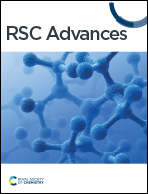Two-photon excited luminescence of sulfur quantum dots for heavy metal ion detection
Abstract
Spectrally-resolved third-order nonlinear optical properties of water-dispersed sulfur quantum dots (SQDs) were investigated in the wavelength range from 740 nm to 820 nm with the two-photon excited emission technique using a tunable femtosecond laser system. The maximum value of the two-photon absorption (TPA) cross-section (σ2) for ∼5.4 nm size SQDs was found to be 185 GM (Goeppert-Mayer unit), while the two-photon brightness (σ2 × η) was found to be 1.5 GM at 780 nm, the wavelength being in the first biological transmittance window. The TPA properties are presented here as appropriate cross-sections normalized per molecular weight which enables meaningful comparison of the nonlinear factors of the studied quantum dots with those of various nanomaterials. The optimized TPA properties of these hydrophilic colloidal SQDs may be potentially useful for detection of Fe3+ metal ions. The experimentally determined limit of Fe3+ detection for both one- and two-photon regime was 10 μmol L−1 (0.6 μg mL−1). Förster resonance energy transfer between SQDs as donors and Fe3+ metal ions as acceptors was confirmed as one of the possible detection mechanisms using a time-correlated single photon counting technique.



 Please wait while we load your content...
Please wait while we load your content...